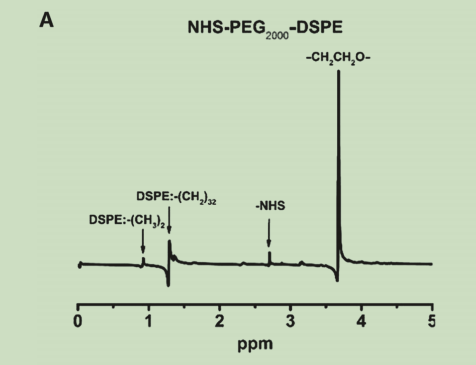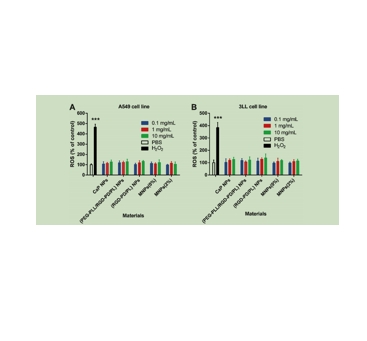文献:Preparation and Biocompatibility Evaluation of PEG-PLL/RGD-PEG-DSPE/Phospholipid/CaP Nanoparticles
文献链接:https://pubmed.ncbi.nlm.nih.gov/29463368/
作者:Jingwen Huang, Xiangyu Zhang, Zhihao Wu, Yufeng Wu, Xiaojie Wu,Yunguang Wang, Hao Jiang, Jing Ma, and Zelai He
相关产品:
PEG2000-PLL5000
原文摘要:(Arginine-Glycine-Aspartic)-methoxy polyethylene glycol-(1,2-distearoyl-sn-glycero-3-phosphoethanolaMine-N) (abbreviation: RGD-PEG2000-DSPE or RGD-PD) was successfully synthesized and verified by 1H-NMR and MALDI-TOF MS.
Polyethylene glycol-poly-L-lysine/RGD-PD/phospholipid/calcium phosphate nanoparticles (PEG-PLL/RGD-PD/PL/CaP NPs or MNPs) were prepared using a novel, simple method conducted at room temperature. Transmission electron microscopy (TEM) analysis showed that the MNPs were spheres of uniform size, with a diameter of ∼30 nm, and smooth surface. Thermogravimetric analysis (TGA) revealed that the PEG-PLL/RGD-PD/PL micelle was packed in the CaP shell.MNPs had little effect on hemolysis, coagulation, cardiac oxidative stress, inflammatory response and DNA damage,indicating negligible cytotoxicity in vitro and in vivo. Experiments in Zebrafish indicated that the MNPs neither affectedthe survival rate and heartbeat rate, nor induced malformation and apoptosis during embryogenesis. In conclusion, these results demonstrate that the newly-developed MNPs have good biocompatibility and a great potential as drug and gene carrier.
PEG2000-PLL5000是指PEG(聚乙二醇)与PLL(聚乳酸)形成的嵌段共聚物,但具体结构可能因不同的合成方法和条件而有所差异。在类似结构的化合物中,mPEG2000-PLLA5000(甲氧基聚乙二醇2000-左旋聚乳酸5000)是一种已知的两亲性AB二嵌段共聚物。主要用于科学研究,如药物/基因递送、封装、细胞粘附和表面修饰等研究。

图为:NHS-PEG2000-DSPE的H-NMR谱
PEG2000-PLL5000在MNPs和MNPs中的制备:采用薄层水化法和生物矿化法制备了MNPs和MNPs。简单地说,将PEG-PLL、RGD-PD和PL和胆固醇的混合物溶解在三氯甲烷中,然后蒸发溶剂形成膜。薄膜在真空干燥器中保存过夜,然后用氯化钙在超声水浴中补水。用氨调整PH值,然后缓慢搅拌加入nh42 HPO4,用氨将pH保持。搅拌后,离心,收集白色沉淀物,用去离子水洗涤,真空干燥。含PEG-PLL的MNPs命名为MNPs,不含PEG-PLL的MNPs命名为MNPs。

图为:(A) A549细胞和(B) 3LL细胞处理48 h后,细胞内ROS含量升高。∗∗∗表示p<为0.001
细胞内氧正常代谢的自然副产物包括超氧阴离子自由基,过氧化氢和一氧化氮。然而,过量的ROS可以损害生物分子,如脂质过氧化和DNA损伤。与阴性对照相比,CaP NPs、MNPs、(RGD-PD/PL)和(PEG-PLL/RGD-PD/PL)NPs处理的A549和3LL细胞内ROS没有增加。A549组NPs组ROS含量最高。此外,处理浓度没有导致明显的变化。这些结果都在推荐的范围内,并表明MNPs对生物体的ROS生成可能是安全的。

 2024-12-17 作者:lkr 来源:
2024-12-17 作者:lkr 来源:

